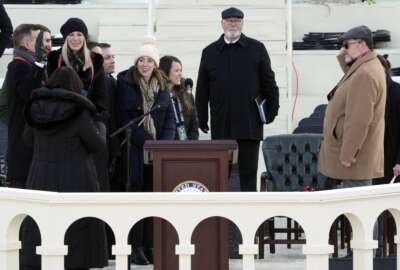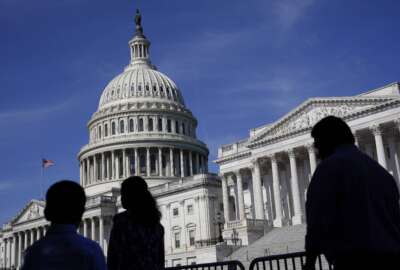GOP lawmakers criticize federal telework as possible return-to-office looms
Republicans' renewed probe into federal telework sets the stage for how President-elect Donald Trump may approach a possible return-to-office mandate for feds.
Just days ahead of President-elect Donald Trump’s inauguration, rising tensions in Congress over the use of federal telework indicate a shift toward an aggressive approach to the federal workforce in the coming administration.
During a hearing Wednesday, Republicans and Democrats on the House Oversight and Government Reform Committee doubled down on familiar arguments in the federal return-to-office debate. But now with a new Congress and the incoming Trump administration, the lawmakers’ latest probe sets the stage for how Trump could address federal telework policies in his second term.
Already, plans are emerging to significantly cut back on telework for federal employees. According to a Jan. 9 Bloomberg report, Trump’s team plans to quickly mandate federal employees to return to the office for a fully in-person work schedule. Returning employees to the office has also been an early priority of the Department of Government Efficiency, a nongovernmental advisory team led by billionaire Elon Musk and former Republican presidential candidate Vivek Ramaswamy.
During Wednesday’s hearing, GOP lawmakers particularly drilled down on the use of federal telework throughout the Biden administration. Many committee Republicans argued that federal telework worsens delays, backlogs and agency services to the public, and exacerbates already low office utilization rates.
“We understand that there are always going to be certain employees who telework,” Oversight Committee Chairman James Comer (R-Ky.) said. “But the overwhelming majority of workers have to work from the office, and there’s no reason why we can’t go back to pre-pandemic levels.”
Comer also announced the reintroduction of his bill, the SHOW UP Act, in the new Congress. The legislation would return federal employees to the telework arrangements they had before the COVID-19 pandemic and largely scale back federal telework options. The bill cleared the House in January 2023, but the Senate did not take any action on the companion bill last Congress.
On the other hand, committee Democrats argued that telework is an important tool for the federal workforce, saying it can improve productivity and customer service, while also benefiting recruitment and retention of employees.
“If we don’t get smart about the deployment of technology, including telework, we will be at a distinct disadvantage with respect to the private sector,” Oversight Committee Ranking Member Gerry Connolly (D-Va.) said. “If we made more investments instead of talking about slashing government investments, we actually might improve customer service dramatically.”
Whether it’s through an executive order from Trump or by way of the SHOW UP Act, a governmentwide return-to-office mandate would likely run into multiple roadblocks. Some agencies have already scaled back their federal office holdings, limiting the amount of space available for a fully in-person workforce. The Office of Management and Budget also expects agencies to shed millions of square feet of building space in the coming years, with many federal employees now on a hybrid work schedule.
On top of that, collective bargaining agreements already in place between agencies and federal unions hold legal standing against any return-to-office plans. During the hearing, Republicans harshly criticized the Social Security Administration, which recently renewed a collective bargaining agreement with the American Federation of Government Employees. Committee members said the November 2024 contract, which extended the current telework policy for 42,000 bargaining unit SSA employees through 2029, would “tie the hands” of Trump in a return-to-office push.
Former SSA Commissioner Martin O’Malley, however, told lawmakers that telework has been beneficial to the agency’s ability to operate effectively. He pointed to improvements in wait times and reductions in backlogs for some SSA services, even with low staffing levels and a rapidly rising number of beneficiaries. At the same time, he said SSA scaled up on-site work in February 2024, and that the new agreement with AFGE retains managers’ discretion to adjust telework levels for staff as needed.
“We did not go backwards on the increased on-site presence that I implemented, and that also helped contribute to the record high in productivity,” O’Malley said.
SSA’s current telework levels put the agency at about the “middle of the pack” for agencies when it comes to hybrid work, O’Malley has said. That comes after the Biden administration issued an April 2023 memo calling for agencies to strike a more equal balance between in-person work and telework following the end of the pandemic.
But telework data has been a longtime sticking point for committee lawmakers too. In a 2023 hearing, Oversight Republicans criticized Kiran Ahuja, former director of the Office of Personnel Management, for not providing a specific number of federal employees governmentwide who were working in the office versus teleworking.
Since then, 2024 data from OMB has shown that more than half of federal employees work entirely in person due to the nature of their job duties. Of those who are eligible for telework, just over 60% of work hours are being spent in the office on average governmentwide.
Although federal telework increased during the COVID-19 pandemic, many during the hearing Wednesday also pointed out that telework has been an option for the feds for much longer. The 2010 Telework Enhancement Act authorized agencies to expand telework options for eligible federal employees. Some feds have been teleworking at least some of the time even years before that, in some cases dating back to the 1990s.
In submitted testimony, AFGE also said it’s a more complex policy for feds than simply employees who telework, versus employees who work in an office building. The federal union urged lawmakers to consider the intricacies of how telework varies based on the type of federal position.
For instance, AFGE said employees such as law enforcement officers, Border Patrol agents and Transportation Security Administration supervisors will often have their work split differently from week to week between an agency office building and the field. Separately, employees like Department of Agriculture food safety inspectors and federal firefighters are assigned to a duty station but work entirely in the field. And any employee classified as a “teleworker” could be working in the office or at home on any combination of days in a week.
“The failure to accurately account for these distinctions has inflated the number of employees whom critics deride as teleworkers as well as the volume of federal building space they claim ‘is vacant,'” AFGE wrote in testimony it submitted to the committee.
Still, Comer expressed enthusiasm for working with Trump, who he said has “been very transparent about his vision to make the federal government more efficient.”
“I think that you’re going to be hearing a lot about that — especially in this committee, which has jurisdiction on the federal workforce — over the next several months,” Comer said. “Hopefully the American taxpayers will get a better return on their investment, and at the very least, the federal workforce will have to show up for work like they do.”
Copyright © 2025 Federal News Network. All rights reserved. This website is not intended for users located within the European Economic Area.
Drew Friedman is a workforce, pay and benefits reporter for Federal News Network.
Follow @dfriedmanWFED






